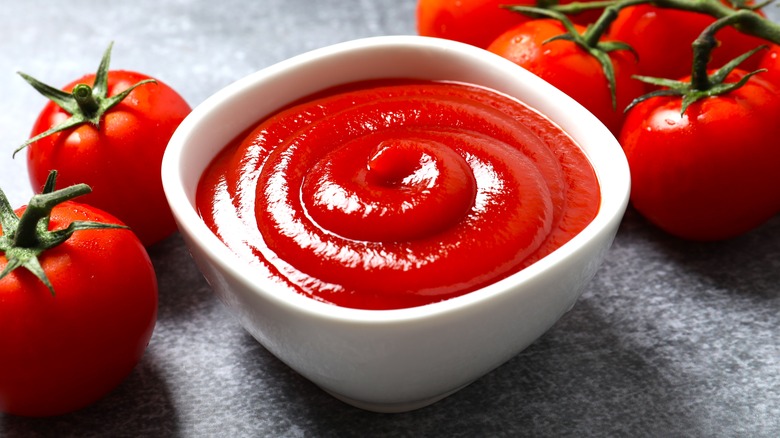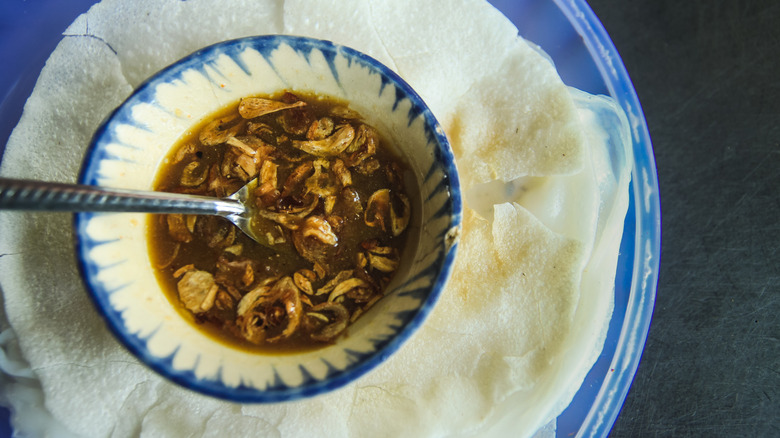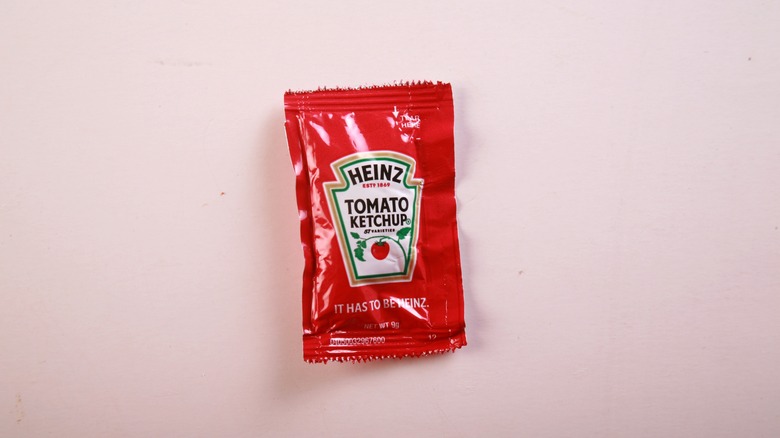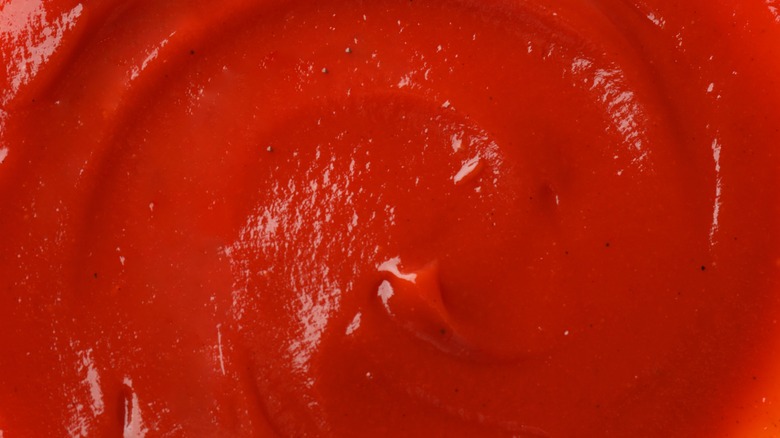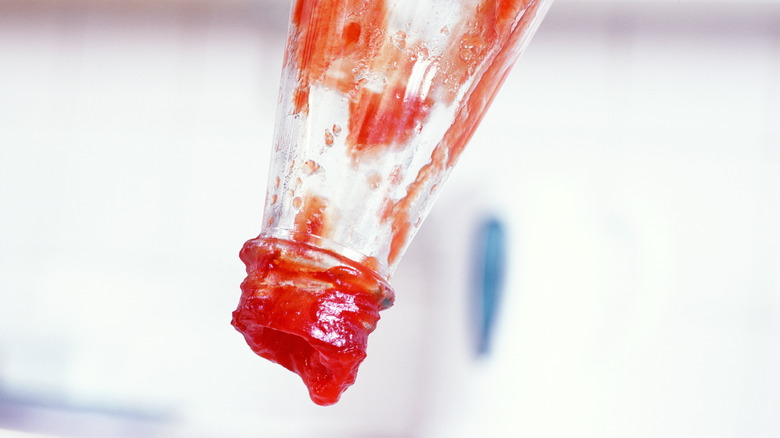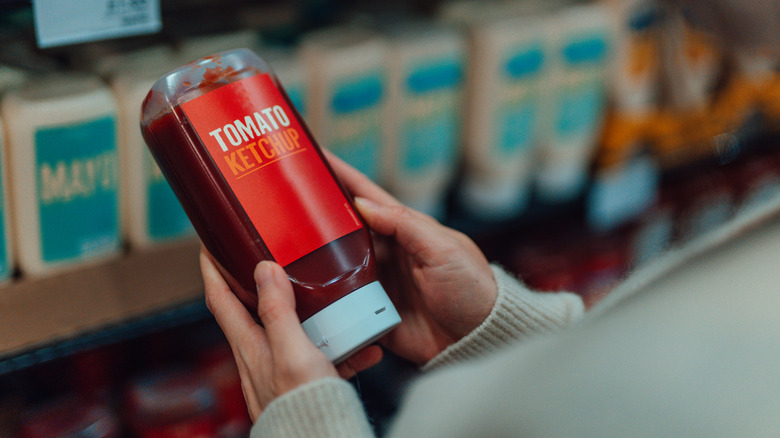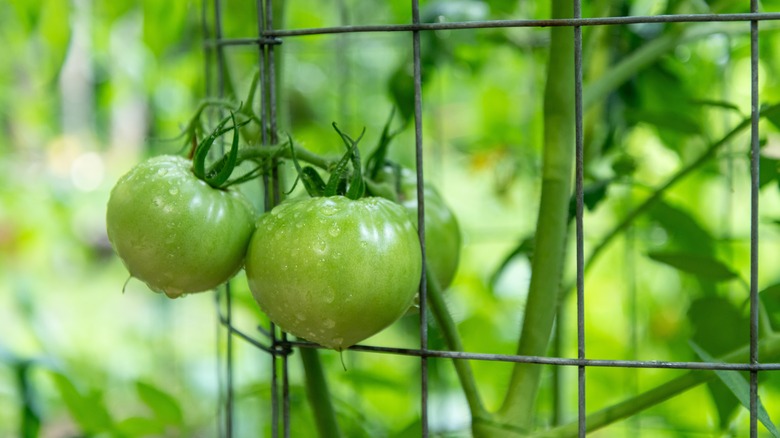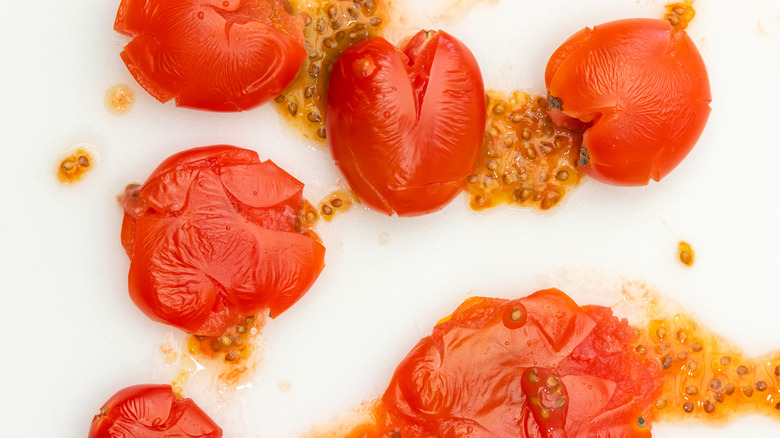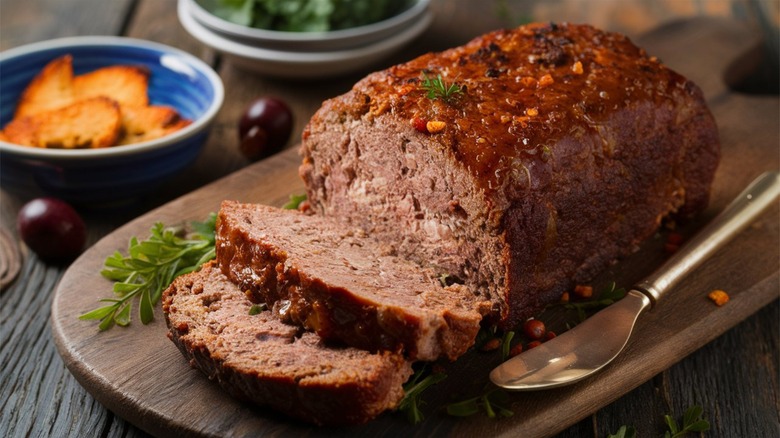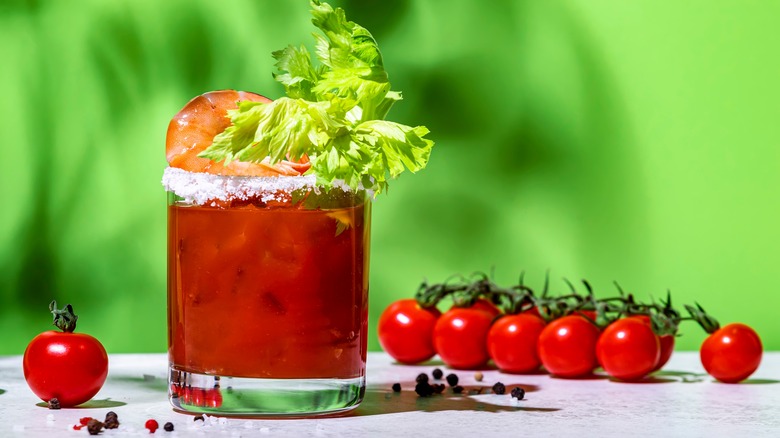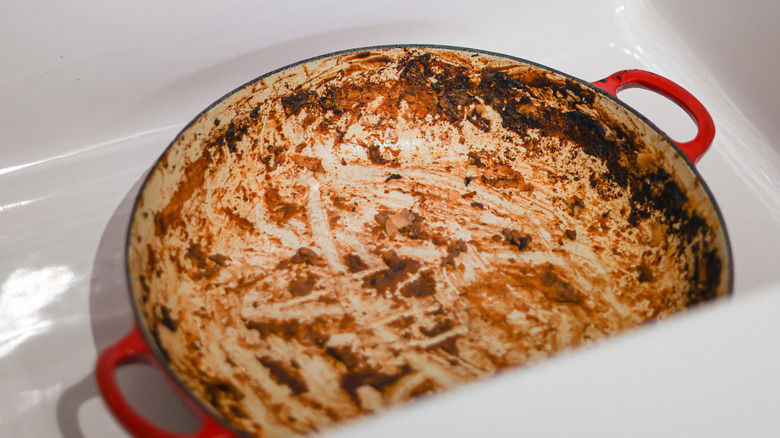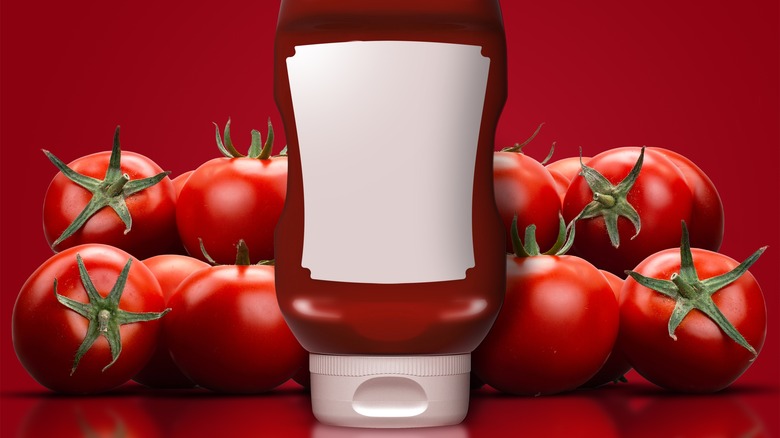Everything You Ever Wanted To Know About Ketchup But Were Too Afraid To Ask
Ketchup is as American as apple pie or peanut butter and jelly. It's a hallmark of cookouts, a critical ingredient in recipes such as meatloaf and baked beans, and easier to make yourself than you might think. Its potential as a health food and cleaning agent further recommends it.
However, many chefs may not know as much about ketchup as they think. Among its more surprising qualities are its history, the wide variation of available ketchup types, and how polarizing it is in some parts of America. Beyond that, you might wonder about its ingredients, its uses beyond the hot dog, and the variations you can try at home.
If so, this guide is for you. You'll learn all things ketchup, from ancient roots to spelling quirks to the more bizarre uses. You'll also learn how to choose, store, and cook with ketchup correctly ... as well as, at long last, a foolproof trick for getting ketchup out of the bottle.
A brief history of ketchup
Put simply, ketchup is a thick, sweet, tomato-based sauce that is usually used as a condiment but may also be used as an ingredient in meat- or veggie-based dishes. The surprising evolution of ketchup began thousands of years ago when it came to America by way of China and Malaysia and didn't include tomatoes (an indigenously American plant). Indeed, the original sauce from Imperial China (a timespan that covers most of the current era) contains soybeans along with meat and fish products, a list of ingredients that would indicate anything but ketchup to modern hamburger lovers.
Today, it is typically used with cookout food and is most famously associated with French fries. It is either lionized with icons such as the World's Largest Catsup Bottle in Illinois or decried as a ruiner of hot dogs. (More on that later.) Suffice it to say, there are few Americans who don't know of its existence.
Catsup vs ketchup: What's in a name?
Perhaps less surprisingly, now that you know a bit more about ketchup's history, the name "ketchup" most likely originated in China as well. "Ke-tsiap" means fish brine, a word that became "ketjap" in Malaysia on its way to the United States.
How to spell ketchup is a subject of some debate. When Heinz first introduced their ketchup in the 1800s, they spelled it "catsup." They kept that spelling until the 1880s. Today, most bottles bear the moniker "ketchup," an Anglicized version of the Malay name, though fancy pants brands still use the less traditional spelling.
While most Americans assume ketchup has to include tomatoes, that's not the case at all. It is a catch-all (ketchall?) term referring to a salty condiment. In the 18th century, ketchup referred to a sauce made of nuts, mushrooms, or oysters, with some stone fruit thrown in from time to time. You can still find recipes for mushroom ketchup (of which Jane Austen was said to be a diehard fan), courtesy of the British. If you're thinking you'd skip that on your fries, you're not alone.
How is ketchup made?
Let's assume for the purposes of this post that ketchup today means tomato ketchup. Even so, it's hard to say what's in ketchup as a whole, since the exact ingredients vary widely depending on the brand and the recipe. As many brands are proprietary about their recipes, a simple list of ingredients does not tell you how those ingredients go together and in what quantities.
That said, there are some standbys, including the all-encompassing tomatoes, as well as vinegar, sugar or brown sugar, and salt. Other ingredients include onions, green peppers, pickling spices, and more. Historically, ketchup could be found in sauce or paste form, its ingredients either boiled together or simply left to marinate with salt. However, we would likely have found the first jar of tomato ketchup to be the fairly recognizable red paste we know today.
Perhaps counterintuitively, the first tomato ketchup recipe was likely born less as a way of making existing ketchup recipes better. More likely, it was invented as a way of preserving tomatoes, which spoiled quickly without preservatives such as sugar or vinegar.
The flavor of ketchup
Ketchup is sweet, sour, and umami (the meaty flavor we associate with beef, mushrooms, seaweed, aged cheeses, and sauces like soy and fish). The flavor of ketchup can vary a lot, however, depending on the ingredients that are used and what else it is paired with. For instance, ketchup tastes sweet against the stronger umami of meatloaf, but tart and acidic against the mild French fry.
Many commercial ketchup brands use corn syrup, which can make it almost candy-like. Homemade recipes tend to be less sweet, although it's easy enough to sweeten them to taste using any commercially available sugar, honey, or syrup. Specialty recipes may be spicy, smoky, balsamic, or similar to barbecue sauce (of which ketchup is often a component). You can also, of course, find a homemade recipe to match any of these flavor profiles if you look online.
How to get it out of the freaking bottle
Many people are sick to death of tapping frenetically on glass ketchup bottles, only to be denied for minutes on end. There's good reason this happens, and it comes down to some cool science. Ketchup is a non-Newtonian fluid (technically a solid), which means its viscosity (how thick it is) varies in relation to the force applied to it. It goes from ever-so-viscous to, with enough force applied, about 1,000 times thinner, at which point it comes out.
If you're doing the brain-exploding emoji right now, you're not alone. This explains so much, both ketchup's initial death grip on the bottle as well as the fact that, when it finally does come out, it happens all at once. Say goodbye to the demure pile of sauce for which you'd so innocently hoped.
The good news is that you can overcome the annoying albatross that is the glass ketchup bottle with a few tips. As Anthony Stickland, a physicist at the University of Melbourne, told Smithsonian Magazine, you first shake it, then turn it upside down and shake it again, then turn it to a 45-degree angle and remove the cap. Afterward, a few light taps should do it.
What should you look for when buying ketchup?
The best ketchup brands do depend somewhat on where you're located, if you have a thriving artisanal food community in your neck of the woods, and personal preference. However, there are a few common traits to look for when shopping for ketchup or buying it online.
First and foremost, remember that appearances can be deceiving. Green-looking labels do not necessarily indicate healthier or more sustainable products. Ideally, you should source your ketchup from trusted brands that don't use loads of salt and sugar. Some is fun (and is often what we're looking for in a good ketchup flavor), but you don't need as much as you might think to get the same flavor. Do a quick comparison of the grams on the back of a few bottles and you'll see how widely it can vary.
In general, look for a simple ingredient list. As ketchup contains acidic tomatoes, vinegar, sugar, and salt (all preservatives on their own), it really shouldn't require anything extra for shelf stability. If you want to know more about a food item, you can enter it into the Environmental Working Group's Food Scores page to get immediate info about its provenance and healthfulness.
What's up with green ketchup?
This is a frankly frivolous trip down memory lane, considering Heinz's green ketchup has been retired. In the same vein as green eggs and ham (which made the internet rounds for a while there), people realized it's really pretty gross. That said, it was basically the same as ketchup, but with buckets of green food dye.
Interestingly, the market's vast enthusiasm for green ketchup, which made Heinz gobs of money when it was first released, did not extend to other colors. Pink, purple, and orange ketchup were giant flops, ultimately leading Heinz to abandon all attempts at anything that was not red. As it turns out, the most likely psychological explanation for this phenomenon is that bright pink, orange, and purple aren't colors associated with tomatoes, whereas both green and red are. People were like, "Ew."
Collectors of weird food items will be happy to know, however, that you can still buy rare unopened bottles online for exorbitant amounts of money. Yay? Heinz EZ Squirt Blastin' Green (with Shrek on the bottle!) can hit as much as $250 on eBay. They sell quickly, but knockoffs such as Great Value's Nickelodeon Slime Sauce are often to be had for a bit less.
How do you make it yourself?
There are several different approaches to making ketchup. However, while original recipes included any number of wild ingredients and often called for them to marinate together rather than cooking and blending, today's approach is more straightforward.
The typical American tomato ketchup recipe, the one you'll find online and in cookbooks, is a cooked reduction of tomatoes and flavoring agents. Some like it hot, while others are gunning to approximate Heinz as closely as possible with a subtle sweetness. Either way, the general approach is to cook a decent quantity (4 pints or so) of grape or plum tomatoes in a saucepan with sugar, vinegar, salt, and pepper. Worcestershire sauce is another common addition. Cook until the tomatoes break down and form a jam-like consistency, at which point you can blend and sieve ... twice if you want to be perfectly sure there are no seed remnants in your condiment.
Common uses for ketchup in the kitchen
Ketchup has a huge range of uses. The obvious is as a condiment or as an ingredient in condiment-like sauces. Special sauce, aka burger sauce, uses a combo of mayo and ketchup, usually spiked with additional ingredients such as mustard, relish, vinegar, and sugar. It's also a must-have ingredient in cocktail sauce, which is in turn a must-have for shrimp. Most grill experts will also tell you that it's an unmissable ingredient in barbecue sauce.
Its critical roles don't end there, though. Ketchup is also a must for dressing meatloaf. The thick red sauce goes well in chili and baked beans, and it is commonly used to flavor soup, from your standard tomato to minestrone and beyond. Indeed, this writer puts ketchup in every batch of stone soup, the recipe for when you've got nothing in the kitchen. Its sweet, vinegary flavor makes it much easier to choke down leftover chickpeas, old cabbage, and sad bits of scallion.
Beyond that, ketchup is often used as a marinade for meat or veggies or to make spaghetti sauce more pungent. That's due to the presence of glutamic acid, which carries that meaty, savory flavor known as "umami."
Ketchup at cocktail hour
While ketchup certainly isn't the most common mixer, it is common enough in a wide range of cocktails. The prairie oyster is an exceptionally weird one, seemingly invented in the 1800s as a somewhat dubious hangover cure, in that it contains the seeds of the next hangover. It calls for one egg yolk delicately placed in a glass, topped with shaken and strained brandy, Worcestershire sauce, tomato juice or ketchup, and salt and pepper.
The gin brace is another that employs ketchup's sweet and sour qualities. It's a combination of the aforementioned liquor with ketchup, lemon juice, Tabasco and Worcestershire sauces, and celery salt. You can also add ketchup to a Bloody Mary to make a version known as a Ruddy Mary.
Mixology can also influence food, as the trendy bloody Mary ketchup recipe goes to show. In addition to the traditional sweet-and-sour condiment, you add hot sauce, horseradish, Worcestershire sauce, hot sauce, and lots of black pepper. But don't worry, that definitely is zero-proof and French fry-safe.
The don'ts of ketchup
Here's where things get a little controversial. Folks have some seriously strong feelings about whether it's okay to put ketchup on hot dogs and spoiler alert, it's not the people who like the combo. Apparently, even the authorities are up in arms about the act of dressing your dog with this rosy condiment. According to the National Hot Dog and Sausage Council (yes, that's a thing), you shouldn't "Use ketchup on your hot dog after the age of 18. Mustard, relish, onions, cheese, and chili are acceptable." Thank goodness for that, at least?
As if that's not enough, the entire Windy City has banned ketchup on hot dogs. Emotionally, at least. With so many other toppings available and a historic pride in their meat production, Chicagoans just can't stomach that sweet sauce atop their delicious dogs.
Other things you shouldn't do with ketchup, you're wondering? Some state unequivocally that you shouldn't use it for chicken wings, corn dogs, or even eggs. Oh, and if you want to avoid a mess, be wary before combining it with baking soda. The vinegar in ketchup will react with the baking soda to expand and froth ... which actually makes for a great science fair volcano.
Ketchup as cleaning agent?
Ketchup comes highly recommended as a cleaning agent. While this doesn't constitute a recipe, per se, it's an entirely food-safe way to clean burnt pots and pans, and it is therefore worth a look-see for every home cook. Plus, it's cheaper than many harsh chemical cleaning agents.
One of ketchup's defining factors is the acid. Both tomatoes and vinegar lend acidity to the blend, which can help dissolve stubborn food particles such as burnt sugars on metal pans. The salt also adds cleaning power, since it is both a scrubbing agent and a grease cutter. In total, ketchup's ingredient list constitutes a pretty effective home remedy for cleaning everything from your pots and pans to your sink to tarnished silver.
Happily, cleaning with ketchup is also easy. To rub away tarnish from pots, pans, silver, and your sink, squirt it on a damp cloth and rub the affected areas. You can clean and wipe immediately, but if the stains are particularly stubborn, you can also let it sit for a while. For burnt sugar, let it sit overnight.
Storing it to last
According to the U.S. Department of Agriculture, ketchup lasts about six months in the refrigerator after opening, the same amount of time that similar tomato-based condiments such as cocktail sauce and chili sauce last. Ketchup owes its long shelf to the high vinegar and tomato content, both of which are quite acidic and help to prevent the growth of pathogens.
Some sources say that you should keep ketchup at room temperature, which is perfectly safe if you have airtight seals and leads to a better flavor. Again, the high acidity and sugar preserve it well at room temp. Restaurants do it all the time, after all, leaving their bottled condiments on tables day in and day out. So the "refrigerate after opening" advice may simply be a matter of flavor rather than food spoilage, though you should always throw out any condiment that changes color, consistency, smell, or flavor.
Nutritional information
Each tablespoon of ketchup contains about 17 calories. It also contains about 4 grams or 1 teaspoon of sugar, when the allotted daily value of added sugar is only 7 teaspoons. The amounts of salt and sugar vary by brand, so some may contain even more. Because ketchup can contain lots of salt and sugar, and because it can aggravate sensitive stomachs, it's best to consume ketchup in moderation. It has negligible amounts of fat, fiber, and protein, so it's certainly not a health food.
However, the high tomato content means ketchup is also high in lycopene, a carotenoid that has a number of health benefits. Lycopene may help prevent cancer, improve heart health, better your skin health, improve male fertility, offer pain relief, and more. Even better, lycopene has some resistance to high temperatures, sometimes holding up for an hour or more (good news for ketchup). This is not true for many antioxidants, which often lose their potency after only brief cooking times. Indeed, some studies indicate that cooking may make the lycopene more available to the body.
Overall, ketchup is a generally low-calorie food that is high in flavor power, so it's fine to use frequently as long as you keep consumption to a reasonable amount. Although it has twice as many calories as mustard, it's only a fourth of the calories of mayo. If you're trying to reduce the ol' waistline and wondering what to squeeze onto your burger, consider a ketchup-for-mayo swap.
